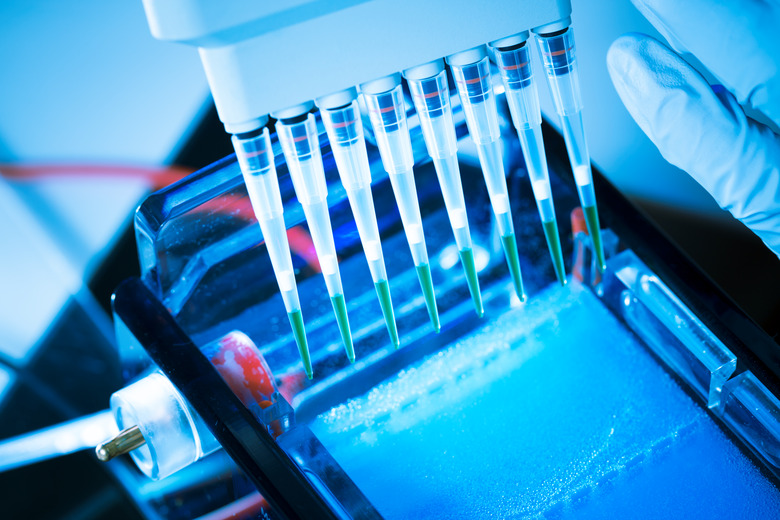What Causes Smearing In Electrophoresis?
Have you ever wondered how scientists study tiny fragments like your DNA? One method is gel electrophoresis. While electrophoresis usually produces clear, easy-to-read bands perfect for scientific interpretation, smeared results sometimes obscure the data.
TL;DR (Too Long; Didn't Read)
Gel electrophoresis allows scientists to visualize digested samples and measure the sizes of the fragments. Smearing results from improperly prepared agarose gels, loading an undiluted sample into the wells or using poor quality samples.
What Is Electrophoresis?
What Is Electrophoresis?
Gel electrophoresis is a way for scientists to visualize digested samples of small molecules such as DNA and estimate the sizes of those fragments. To perform electrophoresis, scientists prepare a gel by suspending agarose in boiling water. The resulting polymerization produces crisscrossed sugar polymers so that the gel looks a bit like a spider web at the chemical level.
Scientists use a cutting instrument to form wells in the gel so they can load very small amounts of digested samples into the wells. Turning on the machine causes electricity to run through the gel, and the fragments in the samples begin to travel from the wells to the other side of the gel. Since the gel is weblike, smaller fragments travel through the matrix quickly, while larger fragments take longer to climb through the matrix. When finished, the gel contains dark bands representing how far different fragments traveled. Scientists measure these bands and use a logarithmic calculation to determine the size of each fragment based on how far it migrated.
Scientists hope for clear bands, but sometimes the bands smear. This smearing is usually the result of poorly prepared gels, loading undiluted samples into the wells or poor quality samples.
Unsatisfactory Gel Preparation
Unsatisfactory Gel Preparation
When it comes to smeared results, one likely culprit is a poorly prepared gel. A satisfactory gel polymerizes evenly, producing a uniform matrix throughout the gel in the casting tray. If part of the gel – usually the lower half – sets before the scientist finishes pouring the entire tray, the resulting gel will be uneven and yield smeared results.
Too Much Sample
Too Much Sample
Before loading samples into the wells, those samples must be dilute enough to run through the gel without overflowing the wells. If a loaded sample is too concentrated because the scientist forgot to dilute it or used an improper dilution factor, the fragments will be too large for the wells and produce smearing.
Poor Quality Sample
Poor Quality Sample
Smearing also results from poor sample quality. For example, a DNA sample contaminated with protein or containing too much salt may produce smearing. Degraded or denatured samples also yield poor results, including smeared bands.
Gel electrophoresis is an amazing way for scientists to visualize digested samples and determine fragment size. Careful preparation of both the gel and the sample minimizes the possibility of smearing and yields clear bands ideal for scientific interpretation.
Cite This Article
MLA
Mayer, Melissa. "What Causes Smearing In Electrophoresis?" sciencing.com, https://www.sciencing.com/causes-smearing-electrophoresis-6404726/. 10 May 2018.
APA
Mayer, Melissa. (2018, May 10). What Causes Smearing In Electrophoresis?. sciencing.com. Retrieved from https://www.sciencing.com/causes-smearing-electrophoresis-6404726/
Chicago
Mayer, Melissa. What Causes Smearing In Electrophoresis? last modified August 30, 2022. https://www.sciencing.com/causes-smearing-electrophoresis-6404726/
